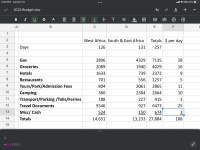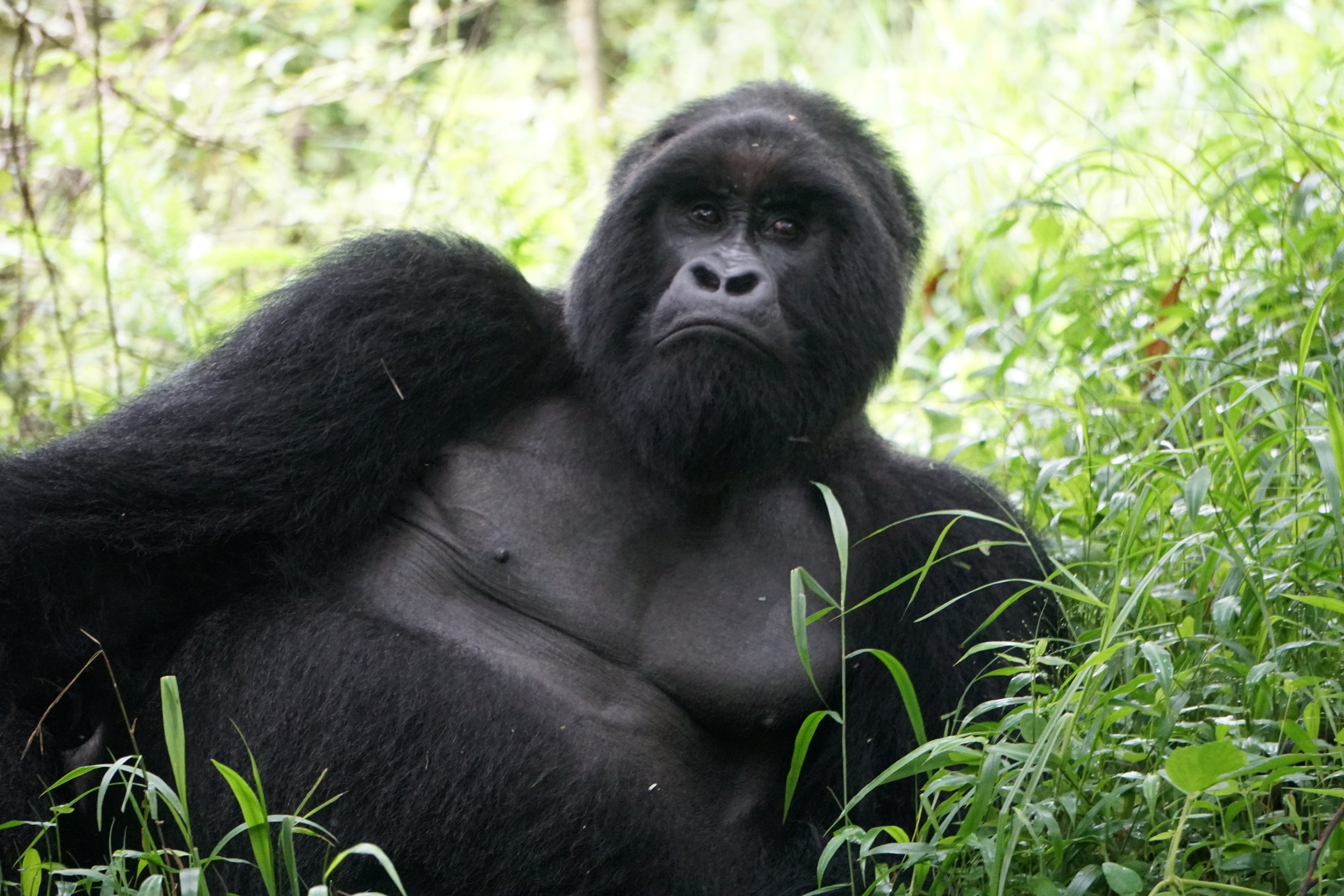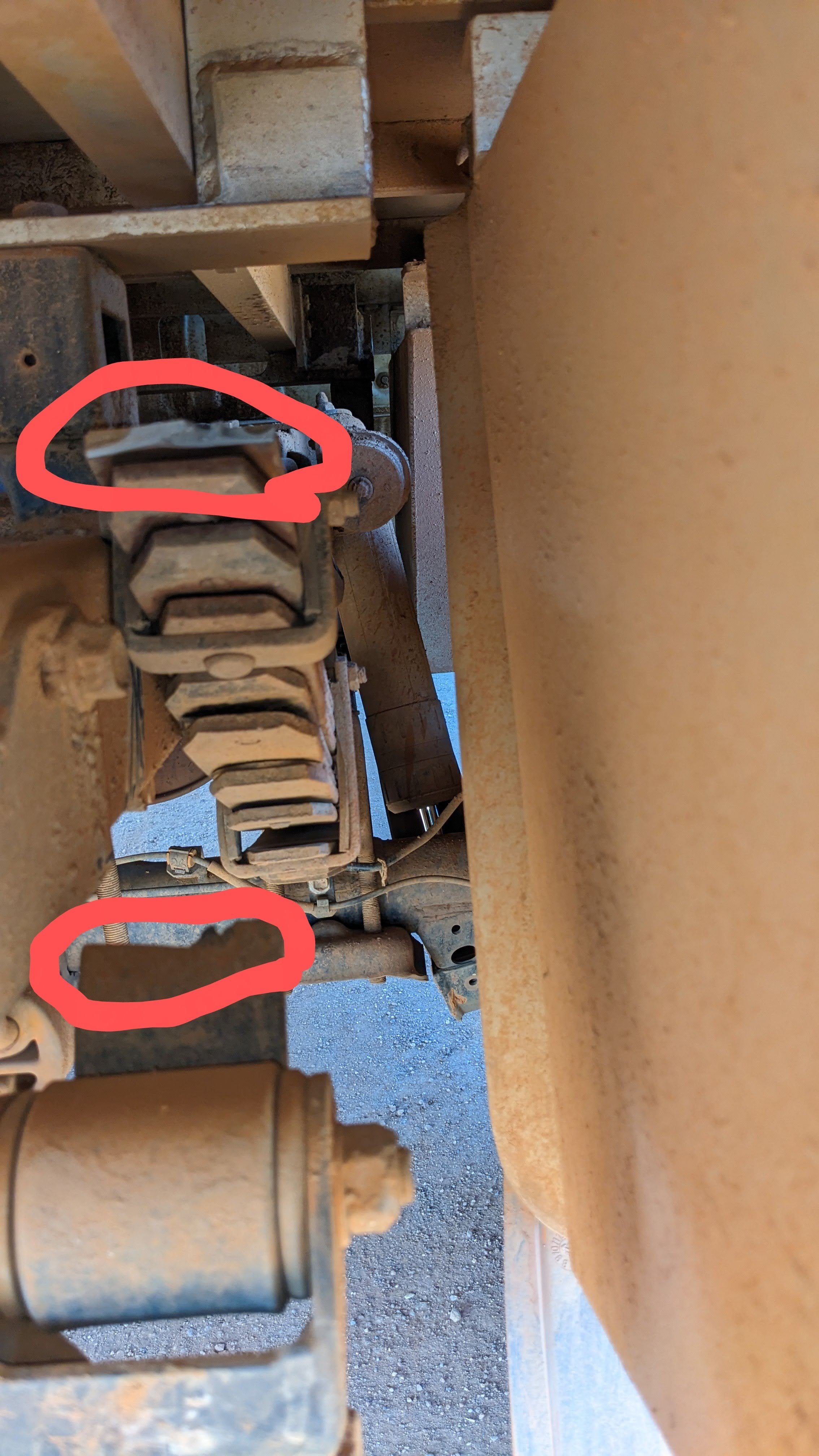Tanzania
Mount Kilimanjaro popping out of the clouds.
We think Tanzania is scenically the most beautiful African country we have been to. It has everything - the gorgeous sandy beaches of Zanzibar, the magic of Ngorongoro Crater, the majestic Mount Kilimanjaro, the endless vistas of the Serengeti with wildlife galore, and the bustling modern city of Dar es Salaam which manages to be both contemporary and capture ancient traditions and culture.
Our one month route through Tanzania
Then, of course there are the people. The kind smiles, the gentle teaching of Swahili words, sharing of culture and knowledge, and the rightful pride in being a peaceful nation. Tanzanians we spoke with delighted in pointing out that in their country people of diverse religions, economic backgrounds and cultures live in harmony side by side. We wish it were so everywhere in the world. The only downside to traveling in Tanzania is that the extraordinary experiences and places come at some of the highest cost we have seen in Africa.
Our 27th African border crossing! Soon there will be a beautiful one stop facility, now still a bit of a work in progress.
We entered Tanzania filled with anticipation, ready once again for some African animal encounters and excited to visit the island of Zanzibar. As is often the case with border crossings, our optimistic guess of 90 mins was wrong by half so we were late and a little at a loss for where to spend the night. We ended up in our least favorite scenario, a budget guest house parking lot, but it was safe and the owner kind and welcoming.
Overlanding is not always camping at scenic wilderness sites, delays at the border meant it was getting dark so we pulled into this guesthouse where the owner kindly made room for us.
Throughout Africa there are a few private overland camps that rise to the top in reputation because of the location, facilities, overlanding owners or uniqueness. (Zebra Bar in Senegal, The Mushroom Farm in Malawi, The Farmhouse in Matobo in Zimbabwe, Kakuako Lodge in Angola, Jungle Junction in Kenya come to mind.) The Old Kisolanza Farmhouse in Iringa is one of those. Right along the main route from the border to Dar es Salaam, The Farmhouse provides lovely separated camping spots, spotless ablutions with warm showers, a historic farm building which serves as the restaurant and bar, excellent wifi and fresh bread baked daily.
And then as a bonus, two guys came by our campsite offering hair cuts and pedicures (we must have looked like we needed it, which we did).
From the Farmhouse it was an easy drive to visit the Isimila Stone Pillars, an intriguing place with stone age relics and a valley of crazy rock towers.
Beautiful old traditional home
Isimila Natural Stone Pillars
We were careful not to hit a giraffe
Because Tanzania is expensive, we were very selective about which national parks we went to. Similar to Zambia, we camped at the edge of a few to get the sense of the area. For our truck, fees to bring it into a park are at least $200, sometimes more. And then there are the person fees, the conservancy fees and the national park camping fees. The least inexpensive parks would cost us close to $400 for the night. But basic campgrounds outside of the national parks averaged $10 a person.
We made our way slowly towards Dar es Salaam, enjoying some beautiful campgrounds along the way.
It was definitely possible to hit wildlife . . . transit road through Mikumi National Park
Camping with a mountainous backdrop - easy to do in Tanzania
Then - the big city! Our first skyscrapers in a long time, it was a bit unnerving to be speeding along a multi lane highway with a city skyline ahead.
It was time to take care of some basic housekeeping so we found an Airbnb with a washer/dryer and got to work.
As we have said many times, cities are not usually our happy place but we surprisingly liked Dar es Salaam. It was very walkable (it actually has sidewalks!), an appealing coastline and a variety of neighborhoods to explore. We also had one major errand to take care of. After a couple of years of international travel and many visas, our passports were full. We had booked an appointment at the US Embassy in Dar es Salaam to get new ones. The whole process was amazingly easy, we filled out a form online in advance, made an appointment a month out and learned that we would receive our passports two weeks after our in person appointment. Time to explore the city.
Local fish market, one of the largest in Africa
And, we had a truck issue that we had been saving for a big city. The aftermath of our experience with the inept off road shop in Cape Town continued. Andy had discovered that when they rebuilt the worn out bushings in the upper control arms, they actually installed them upside down and on the wrong side. So a visit to a (also highly recommended but much more professional) shop in Dar es Salaam got them re-installed the right way round.
For Dawn, no city exploration is complete with a visit to local artists so we made sure to go to the Tinga Tinga Arts Cooperative Society to learn more about this unique Tanzanian art style.
Dawn with artist Shibumi displaying the painting we could not live without
With two weeks to fill before we could pick up our passports at the embassy, we headed south for some beach time combined with a visit to a Unesco ruins site.
The sun goes down at Kilwa Beach Lodge, one of our favorite spots
Using Kilwa beach as our base, we arranged for a day trip out to the Kilwa Kisiwani ruins, remnants of a 13th-16th century East African trading center. The trip involved hiring a guide and a boat which our campground hosts were kind to set up for us.
First view of Kilwa Kisiwani ruins from our boat
Ancient mosque
And among the ruins on the island, a traditional village with people living in beautifully designed stone homes with thatch roofs
Brilliant sunny day at Kilwa Beach lodge. Camping does not get any better than this. (Well, when you flushed the toilet the pipe providing the water would pop off the wall and flood the room, but other than that . . )
As we continued our journey our days of brilliant sunshine slowly faded away as we entered the realities of wet season. We got used to the sight of stormy skies and spontaneous thunder and lightening accompanied by torrential downpours.
Feeling like we had well explored the area, we headed north to camp outside Nyerere National Park along the Selous River.
Storm clouds approaching, becoming a familiar sight
Continuing to watch the budget, we enjoyed camping on the outskirts of the national park then headed back to the Dar es Salaam to catch the ferry out to Zanzibar.
We opted not to take the truck to Zanzibar so found our way to Kipepeo Beach Village outside Dar es Salaam which provided both beach side camping and $5 a day storage for vehicles.
View from the camper one morning at Kipepeo Beach. We were admiring beach life and the gorgeous fabrics worn by the Masai people.



![[IMG] [IMG]](https://images.squarespace-cdn.com/content/v1/5eb85920d2ae880e0ff1526f/c718e541-92f7-4154-94d1-ae1c415c77d9/Malawi.jpg)
![[IMG] [IMG]](https://images.squarespace-cdn.com/content/v1/5eb85920d2ae880e0ff1526f/f0f6a867-66f2-41ae-b155-f79eaf889c64/7.jpg)
![[IMG] [IMG]](https://images.squarespace-cdn.com/content/v1/5eb85920d2ae880e0ff1526f/42fd95bf-df7e-40fe-8159-7c4c5d9d7d22/1.jpg)
![[IMG] [IMG]](https://images.squarespace-cdn.com/content/v1/5eb85920d2ae880e0ff1526f/20bf5144-ce2c-4548-99e5-25f97bb4aa08/4.jpg)
![[IMG] [IMG]](https://images.squarespace-cdn.com/content/v1/5eb85920d2ae880e0ff1526f/ec59914f-16cd-49a6-a294-8c0f32c261d5/6.jpg)
![[IMG] [IMG]](https://images.squarespace-cdn.com/content/v1/5eb85920d2ae880e0ff1526f/d4cc19e6-8c88-4dcc-8838-cfbbce9fc016/9.jpg)
![[IMG] [IMG]](https://images.squarespace-cdn.com/content/v1/5eb85920d2ae880e0ff1526f/4b865b08-d785-41ff-93f0-816616b5e5ec/10.jpg)
![[IMG] [IMG]](https://images.squarespace-cdn.com/content/v1/5eb85920d2ae880e0ff1526f/d486e14c-9da0-426b-8360-1734bbb1b155/11.jpg)
![[IMG] [IMG]](https://images.squarespace-cdn.com/content/v1/5eb85920d2ae880e0ff1526f/0d269c54-94fe-4463-a86b-952f853a3bf7/12.jpg)
![[IMG] [IMG]](https://images.squarespace-cdn.com/content/v1/5eb85920d2ae880e0ff1526f/6e8a7655-a794-471d-b0d3-7fdad0c19f47/14.jpg)
![[IMG] [IMG]](https://images.squarespace-cdn.com/content/v1/5eb85920d2ae880e0ff1526f/9a164d22-e76f-4ad8-a50d-7dbeee24fb66/13.jpg)
![[IMG] [IMG]](https://images.squarespace-cdn.com/content/v1/5eb85920d2ae880e0ff1526f/e868a0be-51b2-44b0-9eae-dd8a2786089a/17.jpg)
![[IMG] [IMG]](https://images.squarespace-cdn.com/content/v1/5eb85920d2ae880e0ff1526f/24823036-1f49-4f2e-9dac-bd8884f8c69f/19.jpg)
![[IMG] [IMG]](https://images.squarespace-cdn.com/content/v1/5eb85920d2ae880e0ff1526f/a69baf36-bf86-46ea-bcf9-4aadad422c6d/16.jpg)
![[IMG] [IMG]](https://images.squarespace-cdn.com/content/v1/5eb85920d2ae880e0ff1526f/4f0e23cd-7861-4124-85ff-6a5c293ca764/2.jpg)
![[IMG] [IMG]](https://images.squarespace-cdn.com/content/v1/5eb85920d2ae880e0ff1526f/6570830a-40e5-43f4-8e0a-d472c2db8768/3.jpg)
![[IMG] [IMG]](https://images.squarespace-cdn.com/content/v1/5eb85920d2ae880e0ff1526f/4c892bf1-acd9-47d1-ab84-8013afbdb2e0/4.jpg)
![[IMG] [IMG]](https://images.squarespace-cdn.com/content/v1/5eb85920d2ae880e0ff1526f/6d11a878-33d7-4658-9040-9356f312a1be/5.jpg)
![[IMG] [IMG]](https://images.squarespace-cdn.com/content/v1/5eb85920d2ae880e0ff1526f/5194478a-0ea4-40e8-bfe0-70a20cca8211/6.jpg)
![[IMG] [IMG]](https://images.squarespace-cdn.com/content/v1/5eb85920d2ae880e0ff1526f/915a9adc-b8a1-4acb-b6c1-6b1710ba86ea/7.jpg)
![[IMG] [IMG]](https://images.squarespace-cdn.com/content/v1/5eb85920d2ae880e0ff1526f/f29fcf71-0c39-4f2b-a324-859adcbb915a/9.jpg)
![[IMG] [IMG]](https://images.squarespace-cdn.com/content/v1/5eb85920d2ae880e0ff1526f/43e9f784-e0ad-4908-a05f-d2c227492afb/10.jpg)
![[IMG] [IMG]](https://images.squarespace-cdn.com/content/v1/5eb85920d2ae880e0ff1526f/751f1183-2819-4105-8024-94cfb268917e/11.jpg)
![[IMG] [IMG]](https://images.squarespace-cdn.com/content/v1/5eb85920d2ae880e0ff1526f/2e05fee8-11e7-491c-9b79-bb7c41ade662/12.jpg)
![[IMG] [IMG]](https://images.squarespace-cdn.com/content/v1/5eb85920d2ae880e0ff1526f/adc57fbd-0d6c-49b5-b210-a93b166fccb3/13.jpg)
![[IMG] [IMG]](https://images.squarespace-cdn.com/content/v1/5eb85920d2ae880e0ff1526f/2f5da3fe-93f9-4b89-bfc3-11f787487afa/14.jpg)
![[IMG] [IMG]](https://images.squarespace-cdn.com/content/v1/5eb85920d2ae880e0ff1526f/1ba6b7ca-db6c-4ae8-9a34-d722212fddd5/15.jpg)
![[IMG] [IMG]](https://images.squarespace-cdn.com/content/v1/5eb85920d2ae880e0ff1526f/af5ef080-abd3-41bb-9cea-ff9fa3466e19/17.jpg)
![[IMG] [IMG]](https://images.squarespace-cdn.com/content/v1/5eb85920d2ae880e0ff1526f/db87fc81-45f7-4130-ba2f-10a4bc37cbea/18.jpg)
![[IMG] [IMG]](https://images.squarespace-cdn.com/content/v1/5eb85920d2ae880e0ff1526f/f9e73ae7-2334-4dfc-b94a-e48648a852db/19.jpg)
![[IMG] [IMG]](https://images.squarespace-cdn.com/content/v1/5eb85920d2ae880e0ff1526f/1daff2bf-b1fa-41c9-8085-3531112bde9f/20.jpg)
![[IMG] [IMG]](https://images.squarespace-cdn.com/content/v1/5eb85920d2ae880e0ff1526f/3c55bbea-4e5c-43f4-ad7a-896e16f2a7b0/21.jpg)
![[IMG] [IMG]](https://images.squarespace-cdn.com/content/v1/5eb85920d2ae880e0ff1526f/533252c6-6de8-41d6-8a2c-d6e9dcfdc45f/22.jpg)
![[IMG] [IMG]](https://images.squarespace-cdn.com/content/v1/5eb85920d2ae880e0ff1526f/db6d3618-c39e-43da-8a6e-830c3ba97059/23.jpg)
![[IMG] [IMG]](https://images.squarespace-cdn.com/content/v1/5eb85920d2ae880e0ff1526f/ba3af43b-552b-49fc-9bdd-b3c674714a18/27.jpg)
![[IMG] [IMG]](https://images.squarespace-cdn.com/content/v1/5eb85920d2ae880e0ff1526f/3db9a1e5-6665-4f21-8898-ed161e3bf7fc/29.jpg)
![[IMG] [IMG]](https://images.squarespace-cdn.com/content/v1/5eb85920d2ae880e0ff1526f/61765913-0434-4e35-b0a5-f1521a99f81e/30.jpg)
![[IMG] [IMG]](https://images.squarespace-cdn.com/content/v1/5eb85920d2ae880e0ff1526f/8d229ab2-e5d6-4485-baab-17a4d4edcfd2/31.jpg)
![[IMG] [IMG]](https://images.squarespace-cdn.com/content/v1/5eb85920d2ae880e0ff1526f/78c287ef-d2ab-4428-93d2-1af5267b32db/35.jpg)
![[IMG] [IMG]](https://images.squarespace-cdn.com/content/v1/5eb85920d2ae880e0ff1526f/34f76e75-205d-45fc-bfe7-ae84c6aeb9ad/34.jpg)
![[IMG] [IMG]](https://images.squarespace-cdn.com/content/v1/5eb85920d2ae880e0ff1526f/5f97572f-ef81-401e-a5f7-269e99de1205/1.jpg)
![[IMG] [IMG]](https://images.squarespace-cdn.com/content/v1/5eb85920d2ae880e0ff1526f/0bab9e1b-a2ad-43a5-b799-140afb11fcae/Tanzania.jpg)
![[IMG] [IMG]](https://images.squarespace-cdn.com/content/v1/5eb85920d2ae880e0ff1526f/0ac0a633-04d1-4ddc-9f8b-b797c9b5ff01/1.jpg)
![[IMG] [IMG]](https://images.squarespace-cdn.com/content/v1/5eb85920d2ae880e0ff1526f/5e55c2ce-23be-4fac-9dff-8f6153807b23/2.jpg)
![[IMG] [IMG]](https://images.squarespace-cdn.com/content/v1/5eb85920d2ae880e0ff1526f/63b66074-afb4-4c2d-b82e-b0aecdc5416c/13.jpg)
![[IMG] [IMG]](https://images.squarespace-cdn.com/content/v1/5eb85920d2ae880e0ff1526f/ec14c068-94e6-4b61-9b9e-b6705b14f885/20.jpg)
![[IMG] [IMG]](https://images.squarespace-cdn.com/content/v1/5eb85920d2ae880e0ff1526f/5fa2eaa7-d84e-4b23-b4a6-d1caeee29acf/1a.jpg)
![[IMG] [IMG]](https://images.squarespace-cdn.com/content/v1/5eb85920d2ae880e0ff1526f/524b6ad8-69df-413a-8d9e-19aac97e21a1/1.jpg)
![[IMG] [IMG]](https://images.squarespace-cdn.com/content/v1/5eb85920d2ae880e0ff1526f/12418bb7-87e6-4c7b-b37f-1bb1e35c9a2e/4.jpg)
![[IMG] [IMG]](https://images.squarespace-cdn.com/content/v1/5eb85920d2ae880e0ff1526f/51dffb87-5fe8-439d-919a-e4a6b7fbde67/2.jpg)
![[IMG] [IMG]](https://images.squarespace-cdn.com/content/v1/5eb85920d2ae880e0ff1526f/bc746817-9822-42e4-a402-adf1a1fd0df7/5.jpg)
![[IMG] [IMG]](https://images.squarespace-cdn.com/content/v1/5eb85920d2ae880e0ff1526f/51ebefad-e71d-460e-bea9-9e6b108fd5d2/8.jpg)
![[IMG] [IMG]](https://images.squarespace-cdn.com/content/v1/5eb85920d2ae880e0ff1526f/5a3c2b92-e8df-48b3-b2f2-66126044231e/9.jpg)
![[IMG] [IMG]](https://images.squarespace-cdn.com/content/v1/5eb85920d2ae880e0ff1526f/a10ff7c7-61ba-4ba6-ac61-e72a950982d1/PXL_20231026_152652697%7E2.jpg)
![[IMG] [IMG]](https://images.squarespace-cdn.com/content/v1/5eb85920d2ae880e0ff1526f/5a604557-7fcf-47a8-9652-bb008b50e464/PXL_20231027_074229017%7E2.jpg)
![[IMG] [IMG]](https://images.squarespace-cdn.com/content/v1/5eb85920d2ae880e0ff1526f/7a9d14ae-2660-40c3-a5c8-7c5782019126/6.jpg)
![[IMG] [IMG]](https://images.squarespace-cdn.com/content/v1/5eb85920d2ae880e0ff1526f/5dea7300-2b9e-4004-a13f-725051c5e665/10.jpg)
![[IMG] [IMG]](https://images.squarespace-cdn.com/content/v1/5eb85920d2ae880e0ff1526f/0a6a7091-ff29-4704-b5e6-bba41f387e3d/13.jpg)
![[IMG] [IMG]](https://images.squarespace-cdn.com/content/v1/5eb85920d2ae880e0ff1526f/a55b41fa-3cba-47f8-adcb-24670d0c27d5/2.jpg)
![[IMG] [IMG]](https://images.squarespace-cdn.com/content/v1/5eb85920d2ae880e0ff1526f/46890aec-e154-4620-85d2-5bc53fffd7e2/6.jpg)
![[IMG] [IMG]](https://images.squarespace-cdn.com/content/v1/5eb85920d2ae880e0ff1526f/557c3df5-b627-42ac-9eb0-535a4243a6de/9.jpg)
![[IMG] [IMG]](https://images.squarespace-cdn.com/content/v1/5eb85920d2ae880e0ff1526f/c6e27557-8521-4974-9f36-3b21e3b46d5c/10.jpg)
![[IMG] [IMG]](https://images.squarespace-cdn.com/content/v1/5eb85920d2ae880e0ff1526f/a4e774fd-10ab-40a1-8a6b-ff3e787a211c/12.jpg)
![[IMG] [IMG]](https://images.squarespace-cdn.com/content/v1/5eb85920d2ae880e0ff1526f/bf6c3174-60ca-4825-9675-a092134f9cd2/14.jpg)
![[IMG] [IMG]](https://images.squarespace-cdn.com/content/v1/5eb85920d2ae880e0ff1526f/3cb7423b-1cc9-478b-a777-a50da1aca6e4/22.jpg)
![[IMG] [IMG]](https://images.squarespace-cdn.com/content/v1/5eb85920d2ae880e0ff1526f/54898267-0959-45e4-90cc-eb42e4c1218f/30.jpg)
![[IMG] [IMG]](https://images.squarespace-cdn.com/content/v1/5eb85920d2ae880e0ff1526f/daf7037a-730e-40f5-9553-d4aa9005c557/2.jpg)
![[IMG] [IMG]](https://images.squarespace-cdn.com/content/v1/5eb85920d2ae880e0ff1526f/51b4946b-5c80-492b-95df-e9a6d821becb/5.jpg)
![[IMG] [IMG]](https://images.squarespace-cdn.com/content/v1/5eb85920d2ae880e0ff1526f/63e9abfa-40a5-45ac-a9de-a29c1fd43299/6.JPG)
![[IMG] [IMG]](https://images.squarespace-cdn.com/content/v1/5eb85920d2ae880e0ff1526f/41df6081-cd2b-4a50-ae41-b2d332004a66/11.JPG)
![[IMG] [IMG]](https://images.squarespace-cdn.com/content/v1/5eb85920d2ae880e0ff1526f/cad02398-e901-4e96-b950-112204207121/11b.jpg)
![[IMG] [IMG]](https://images.squarespace-cdn.com/content/v1/5eb85920d2ae880e0ff1526f/a3c96080-3da9-459d-9826-389fe2a95723/12.jpg)
![[IMG] [IMG]](https://images.squarespace-cdn.com/content/v1/5eb85920d2ae880e0ff1526f/c0cd5790-cf74-4abf-88b1-ca7bf671bb0b/13.JPG)
![[IMG] [IMG]](https://images.squarespace-cdn.com/content/v1/5eb85920d2ae880e0ff1526f/791d9ada-ca3a-454c-b536-777de948e15b/13b.JPG)
![[IMG] [IMG]](https://images.squarespace-cdn.com/content/v1/5eb85920d2ae880e0ff1526f/74f43267-4d8e-44be-ba8f-85f443724493/15.JPG)
![[IMG] [IMG]](https://images.squarespace-cdn.com/content/v1/5eb85920d2ae880e0ff1526f/f2dc1cf1-d88c-487f-85a2-3f10c51746c7/17.JPG)
![[IMG] [IMG]](https://images.squarespace-cdn.com/content/v1/5eb85920d2ae880e0ff1526f/86e92ec8-8677-49de-9649-ded17b64766f/26.JPG)
![[IMG] [IMG]](https://images.squarespace-cdn.com/content/v1/5eb85920d2ae880e0ff1526f/c3480fde-63e3-4386-8a16-f2035afd2243/27.JPG)
![[IMG] [IMG]](https://images.squarespace-cdn.com/content/v1/5eb85920d2ae880e0ff1526f/743528cb-9e09-4dac-bc2e-7ff627b691dd/37.JPG)
![[IMG] [IMG]](https://images.squarespace-cdn.com/content/v1/5eb85920d2ae880e0ff1526f/53c7abf5-2e7c-46ab-a9f6-e1e40ed470cb/43.jpg)
![[IMG] [IMG]](https://images.squarespace-cdn.com/content/v1/5eb85920d2ae880e0ff1526f/d8717a13-389a-4938-84d1-2b0608fc6337/8.JPG)
![[IMG] [IMG]](https://images.squarespace-cdn.com/content/v1/5eb85920d2ae880e0ff1526f/509f9635-13fe-44f0-b8a3-d996bd8f1ac8/Rwanda+%26+Uganda.jpg)
![[IMG] [IMG]](https://images.squarespace-cdn.com/content/v1/5eb85920d2ae880e0ff1526f/295dbd95-8f34-453f-a51e-e750beecd297/1.jpg)
![[IMG] [IMG]](https://images.squarespace-cdn.com/content/v1/5eb85920d2ae880e0ff1526f/e775f0d5-e91b-490b-bfdf-3361ea51c71d/2.jpg)
![[IMG] [IMG]](https://images.squarespace-cdn.com/content/v1/5eb85920d2ae880e0ff1526f/8f3a5dff-67a8-4d43-9c9a-471871490f25/3.jpg)
![[IMG] [IMG]](https://images.squarespace-cdn.com/content/v1/5eb85920d2ae880e0ff1526f/48392410-672d-431f-b980-47f31d0d60c0/4.jpg)
![[IMG] [IMG]](https://images.squarespace-cdn.com/content/v1/5eb85920d2ae880e0ff1526f/42595b29-1446-411c-ad30-60ef0f15ffa3/5.jpg)
![[IMG] [IMG]](https://images.squarespace-cdn.com/content/v1/5eb85920d2ae880e0ff1526f/d24f54b8-7414-480d-8189-0a6af8f9c78d/6.jpg)
![[IMG] [IMG]](https://images.squarespace-cdn.com/content/v1/5eb85920d2ae880e0ff1526f/f4962789-366e-4f4b-a2cc-f8c7721987e0/7.jpg)
![[IMG] [IMG]](https://images.squarespace-cdn.com/content/v1/5eb85920d2ae880e0ff1526f/2de5ce5b-2b9f-4abb-8cd9-74e59a50c138/8.jpg)
![[IMG] [IMG]](https://images.squarespace-cdn.com/content/v1/5eb85920d2ae880e0ff1526f/f5075459-5788-4cd3-97f8-7fefea6824cd/9.jpg)
![[IMG] [IMG]](https://images.squarespace-cdn.com/content/v1/5eb85920d2ae880e0ff1526f/9e29c179-e8d8-42a7-b26f-77273b32c854/10.jpg)
![[IMG] [IMG]](https://images.squarespace-cdn.com/content/v1/5eb85920d2ae880e0ff1526f/5cf5c977-73e0-4b04-9b8a-fbaed2af652a/11.jpg)
![[IMG] [IMG]](https://images.squarespace-cdn.com/content/v1/5eb85920d2ae880e0ff1526f/7f66856c-6b47-4833-bee3-4317a49a3d5a/12.jpg)
![[IMG] [IMG]](https://images.squarespace-cdn.com/content/v1/5eb85920d2ae880e0ff1526f/24339fbd-3106-4e7f-bcf7-f1dabd9b6a80/13.jpg)
![[IMG] [IMG]](https://images.squarespace-cdn.com/content/v1/5eb85920d2ae880e0ff1526f/2467522f-c590-40c8-8afd-570d1c1d3a9e/1.jpg)




















![[IMG] [IMG]](https://images.squarespace-cdn.com/content/v1/5eb85920d2ae880e0ff1526f/33969aa3-edc8-4ecf-8445-27d117d3eb7a/44.jpg)
![[IMG] [IMG]](https://images.squarespace-cdn.com/content/v1/5eb85920d2ae880e0ff1526f/0346e464-67dc-4c8f-b5c4-4d8c5b097b18/carnet.jpeg)
![[IMG] [IMG]](https://images.squarespace-cdn.com/content/v1/5eb85920d2ae880e0ff1526f/2681460d-5e40-47fd-b8e6-fe568d4b5d63/3.jpg)
![[IMG] [IMG]](https://images.squarespace-cdn.com/content/v1/5eb85920d2ae880e0ff1526f/f3408482-891f-40c8-9e59-98b606de342c/5a.jpg)
![[IMG] [IMG]](https://images.squarespace-cdn.com/content/v1/5eb85920d2ae880e0ff1526f/80d8abb7-2078-4ba9-bf03-6c8aef702b65/7.jpg)
![[IMG] [IMG]](https://images.squarespace-cdn.com/content/v1/5eb85920d2ae880e0ff1526f/5a014318-7d13-42d5-8a6b-02d1b0a765d5/8.jpg)
![[IMG] [IMG]](https://images.squarespace-cdn.com/content/v1/5eb85920d2ae880e0ff1526f/833da6d6-0964-41a5-8eae-5d985f7b7ff6/10.jpg)
![[IMG] [IMG]](https://images.squarespace-cdn.com/content/v1/5eb85920d2ae880e0ff1526f/9b113fc0-2197-43c3-bac0-def273f10611/15.jpg)
![[IMG] [IMG]](https://images.squarespace-cdn.com/content/v1/5eb85920d2ae880e0ff1526f/e2486bd3-174a-4616-9582-768870183688/Kenya.jpg)
![[IMG] [IMG]](https://images.squarespace-cdn.com/content/v1/5eb85920d2ae880e0ff1526f/7c79fe75-106e-4141-9e30-6cc5df5967af/19.jpg)
![[IMG] [IMG]](https://images.squarespace-cdn.com/content/v1/5eb85920d2ae880e0ff1526f/59ed65ac-2a15-4294-9124-62751d9a92bc/22.JPG)
![[IMG] [IMG]](https://images.squarespace-cdn.com/content/v1/5eb85920d2ae880e0ff1526f/f99d55db-b32e-4a70-ae62-f2da03610b04/25.JPG)
![[IMG] [IMG]](https://images.squarespace-cdn.com/content/v1/5eb85920d2ae880e0ff1526f/9741f690-0417-4592-be94-d658b203b40d/27.JPG)
![[IMG] [IMG]](https://images.squarespace-cdn.com/content/v1/5eb85920d2ae880e0ff1526f/bbd546f8-0c0f-4e1f-93a7-5bde62c37d13/PXL_20231220_031623888%7E3.jpg)
![[IMG] [IMG]](https://images.squarespace-cdn.com/content/v1/5eb85920d2ae880e0ff1526f/2452b04e-5171-4981-b46a-93945e56a2e0/33.jpg)
![[IMG] [IMG]](https://images.squarespace-cdn.com/content/v1/5eb85920d2ae880e0ff1526f/83348eb8-99a2-41ba-b49a-f6d022d47a2e/PXL_20231219_123358029%7E2.jpg)
![[IMG] [IMG]](https://images.squarespace-cdn.com/content/v1/5eb85920d2ae880e0ff1526f/f1c18043-6d7c-408e-999b-fa7bfd96523e/40.jpg)
![[IMG] [IMG]](https://images.squarespace-cdn.com/content/v1/5eb85920d2ae880e0ff1526f/ab7bb757-e7be-4e67-8cb4-591e113cd17d/40b.JPG)
![[IMG] [IMG]](https://images.squarespace-cdn.com/content/v1/5eb85920d2ae880e0ff1526f/7a30613d-5386-4d9b-a1fe-37e9c2d3051a/41b.JPG)
![[IMG] [IMG]](https://images.squarespace-cdn.com/content/v1/5eb85920d2ae880e0ff1526f/c476785b-991e-4436-b168-ee238f6e372c/41d.JPG)